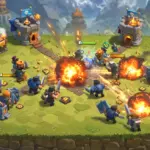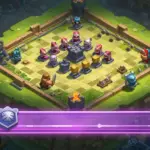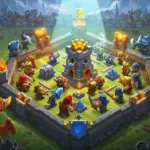Clash Royale Defensive Strategies: Master Tower Protection
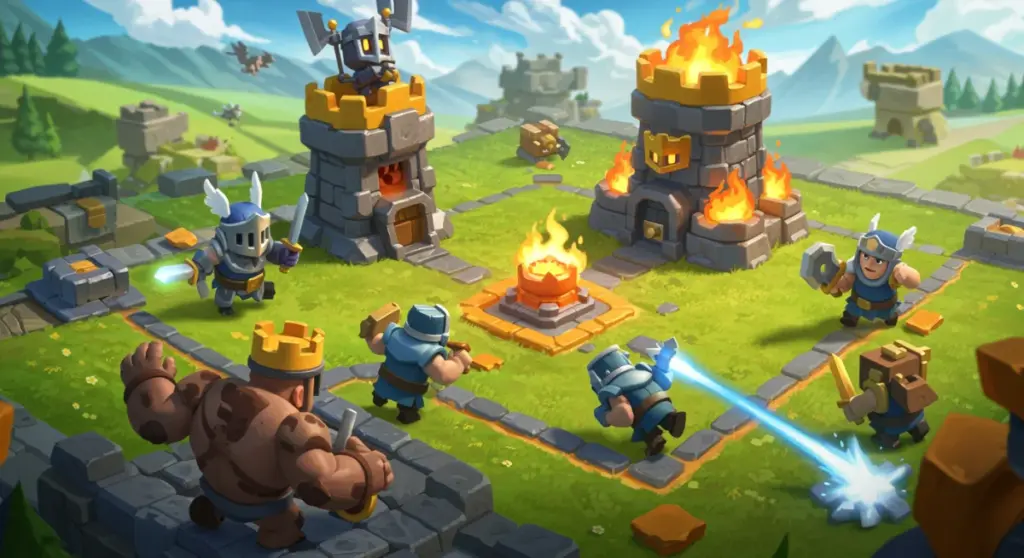
Anúncios
Mastering Clash Royale defensive strategies is paramount for safeguarding your towers and ensuring victory, demanding astute card placement, judicious elixir management, and a comprehensive understanding of troop interactions.
In the fast-paced world of Clash Royale, success hinges not just on offense, but critically on how well you can defend. Understanding and implementing effective Clash Royale Defensive Strategies can be the difference between a triumphant three-crown win and a devastating defeat.
Understanding the Core Principles of Defense
Effective defense in Clash Royale is a multi-faceted skill that goes beyond simply dropping troops. It involves a deep understanding of card interactions, elixir management, and anticipating your opponent’s moves. A strong defensive backbone allows you to preserve your towers, generate elixir advantages, and launch devastating counter-pushes.
At its heart, defense in Clash Royale is about efficiency. Every elixir spent defensively should ideally serve multiple purposes: neutralizing the threat, minimizing tower damage, and setting up your next offensive push. This requires a proactive rather than reactive mindset, always thinking a few steps ahead of your opponent.
Elixir Management: The Foundation of Defense
Elixir is the lifeblood of Clash Royale, and its efficient management is crucial for defensive success. Every card has an elixir cost, and understanding how to spend your elixir wisely on defense can create significant advantages. Overspending on defense can leave you vulnerable to counter-attacks, while underspending can lead to tower loss.
- Positive Elixir Trades: Aim to use cards that cost less elixir to counter cards that cost more. For example, using a 3-elixir Knight to stop a 4-elixir Musketeer creates a positive elixir trade.
- Saving Elixir for Counter-Pushes: Sometimes, allowing minimal tower damage to save elixir for a strong counter-push is a better long-term strategy than overdefending.
- Elixir Cycle Awareness: Knowing your deck’s average elixir cost and how quickly you can cycle through cards helps you prepare for incoming threats and defensive rotations.
Mastering elixir management is an ongoing process that improves with experience. It involves making split-second decisions under pressure, constantly weighing the cost and benefit of each defensive play. A well-managed elixir bar is often the hallmark of a skilled defensive player.
Strategic Card Placement and Timing
The placement and timing of your defensive cards are arguably the most critical aspects of successful defense. A card placed just one tile off can drastically alter its effectiveness, leading to unnecessary tower damage or even a lost tower. Understanding the nuances of troop movement, targeting, and attack ranges is paramount.
Consider the attack patterns of your opponent’s troops. Do they target buildings, ground troops, or air troops? Knowing this helps you choose the correct counter and position it optimally. For instance, placing a building-targeting troop like a Giant in the middle can draw both lane attacks, allowing your towers to chip away at them.
Kiting and Luring: Manipulating Enemy Movement
Kiting and luring are advanced defensive techniques that involve manipulating enemy troop paths to maximize your tower’s damage output and minimize damage to your own troops. This often involves placing defensive units or buildings in the center of your arena.
- Central Building Placement: Structures like the Inferno Tower, Tesla, or Cannon placed 3-4 tiles from the river in the middle can pull Hog Riders, Giants, Golems, and even Balloons, allowing both Princess Towers to target them.
- Troop Luring: Small, inexpensive troops like Skeletons or Goblins can be used to pull high-damage, single-target units like the Mini P.E.K.K.A. or Prince towards the center, away from your towers, and into the range of both Princess Towers.
- Pathing Manipulation: Understanding how troops path around obstacles can help you create advantageous situations, forcing enemies to walk further, thus taking more tower damage.
The art of kiting and luring requires precise timing and a good grasp of troop movement mechanics. When executed correctly, these techniques can result in significant elixir advantages and save your towers from heavy damage, turning the tide of the battle in your favor.
Deck Building for Robust Defense
Your deck composition plays a pivotal role in your defensive capabilities. A well-balanced deck should include a variety of cards capable of dealing with different types of threats, ensuring you have an answer for almost any offensive push your opponent can throw at you. This includes a mix of air, ground, splash, and single-target damage units.
When constructing your deck, think about defensive synergies. How do your cards complement each other when defending? For example, a splash damage unit like a Baby Dragon combined with a tanky unit like a Knight can effectively clear swarms while absorbing damage. Having multiple defensive options ensures flexibility.
Essential Defensive Card Archetypes
To build a strong defensive deck, consider including cards from these archetypes:
- Tanks/Mini-Tanks: Cards like Knight, Valkyrie, or Mega Knight can absorb damage, protecting your glass cannon units and towers.
- Splash Damage Units: Wizard, Baby Dragon, Executioner, or Valkyrie are excellent for clearing swarms of low-health troops like Skeleton Army or Minion Horde.
- Single-Target Damage Units: Mini P.E.K.K.A., Musketeer, Hunter, or Inferno Dragon are crucial for taking down high-health tanks and win conditions quickly.
- Defensive Buildings: Inferno Tower, Tesla, Bomb Tower, or Cannon can provide crucial distraction, damage, and kiting capabilities against heavy pushes.
- Spells: Arrows, Zap, Log, Fireball, or Poison are versatile tools for clearing swarms, finishing off weakened troops, or resetting charges.
A balanced defensive deck is one that can adapt to various opponent strategies. It’s not about having the strongest individual cards, but about how effectively they work together to mitigate damage and create counter-push opportunities. Regular deck testing and refinement are key to finding your optimal defensive setup.
Countering Popular Offensive Strategies
Knowing your enemy is half the battle. Familiarizing yourself with common offensive strategies and understanding their weaknesses allows you to formulate effective defensive responses. Each popular win condition in Clash Royale has specific counters that, when executed correctly, can neutralize the threat with minimal elixir expenditure.
For instance, a Hog Rider push often comes with support troops. Understanding whether to target the Hog first or its support can make a huge difference. Similarly, dealing with a Golem or Lava Hound push requires a different approach, prioritizing damage to the tank or its support units.
Specific Counters for Common Threats
Let’s look at how to approach some frequently encountered offensive units:
Hog Rider
The Hog Rider is a fast, building-targeting unit that can quickly reach your tower. Effective counters often involve pulling it to the center or applying heavy damage quickly.
- Tornado: Pulls the Hog Rider to the King Tower, activating it for future defense.
- Defensive Buildings: Cannon, Tesla, or Inferno Tower placed centrally will distract the Hog.
- Mini P.E.K.K.A./Prince: High damage units can quickly eliminate the Hog before it gets too many hits.
Always be prepared for the Hog Rider’s support. If an Ice Golem is leading, focus on the Hog first. If it’s a Musketeer or Electro Wizard, deal with them before they deal too much damage to your counter.
Golem/Lava Hound
These heavy tanks soak up a lot of damage and often come with strong air or ground support. The key is usually to target the support units first, then deal with the tank.
- Inferno Tower/Dragon: Excellent for melting high-HP tanks.
- Splash Damage Units: Wizard, Executioner, Baby Dragon are great for clearing swarms behind the tank.
- Minions/Mega Minion: High air damage for Lava Hound and its pups.
When facing these tanks, don’t overcommit elixir defensively. Allow your towers to contribute damage, and focus on creating a positive elixir trade against the support troops to set up a counter-push. Patience is key.
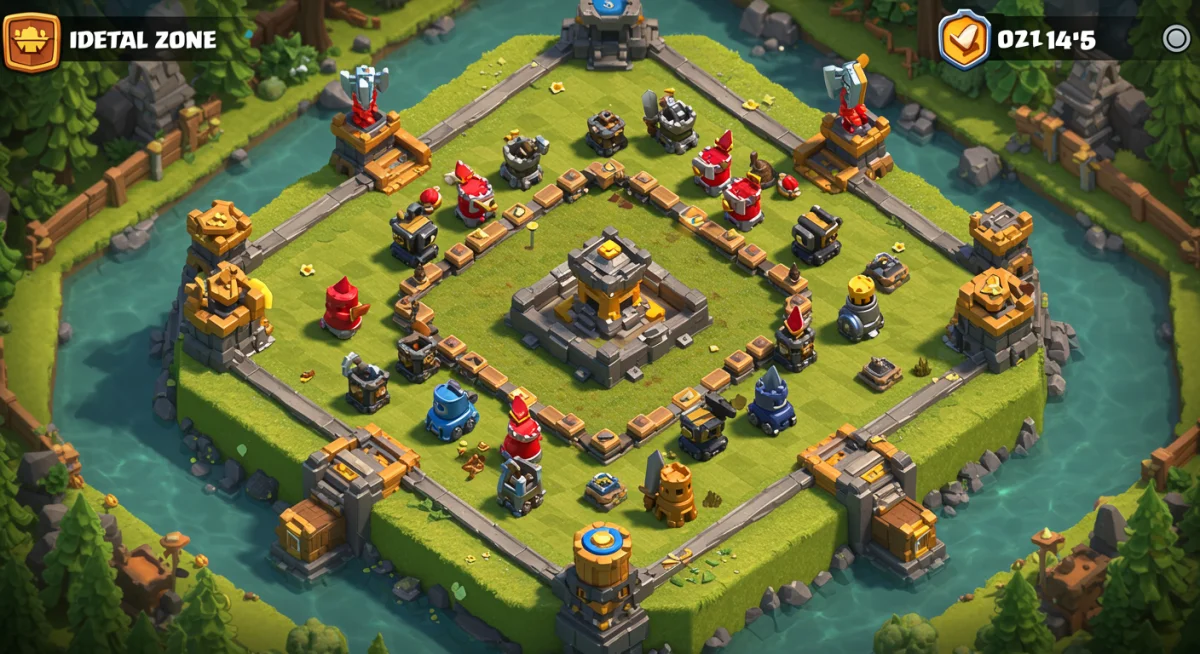
Advanced Defensive Techniques and Mind Games
Beyond basic card placements and elixir trades, Clash Royale offers a layer of advanced defensive techniques that can truly elevate your gameplay. These involve understanding opponent psychology, predicting moves, and using the arena to your advantage in unconventional ways. Mastering these can often win you games you might otherwise lose.
One such technique is baiting out specific cards. If you know your opponent has a Fireball, you might place a cheaper unit in a way that forces them to use it, clearing the way for a more valuable troop later. This requires keen observation of their deck and playstyle.
Predictive Spells and Pre-placements
Experienced players often use predictive spells or troop pre-placements to shut down common pushes before they even fully materialize. This relies on anticipating where and when your opponent will play their win condition.
- Predictive Fireball/Poison: If an opponent consistently places a Witch behind their Golem, a well-timed Fireball or Poison can eliminate her before she spawns too many skeletons.
- Pre-placing Buildings: Against a Hog Rider or Balloon, pre-placing an Inferno Tower or Tesla a few seconds before they cross the bridge can catch them off guard and ensure it targets them immediately.
- Skeletons/Goblins for Fast Units: Dropping cheap troops directly onto a charging Prince or Bandit can often stop their charge damage entirely.
Predictive plays carry an inherent risk; if your prediction is wrong, you might have wasted elixir. However, when successful, they can be incredibly rewarding, creating huge elixir advantages and completely disrupting your opponent’s rhythm. It’s a gamble, but a calculated one, based on their previous plays.
Maintaining Elixir Advantage and Counter-Pushing
The ultimate goal of strong defense in Clash Royale isn’t just to protect your towers, but to transform defensive plays into offensive opportunities. Every successful defense that results in a positive elixir trade or leaves your defensive troops alive should ideally translate into a counter-push. This is where games are truly won.
When your defensive units survive with significant health, they become valuable assets for a counter-attack. Supporting these surviving units with new offensive cards can create a powerful push that your opponent, having just committed elixir to their attack, might struggle to defend.
Turning Defense into Offense
Successfully transitioning from defense to offense requires careful elixir management and strategic card deployment. It’s about capitalizing on your opponent’s overcommitment and turning their failed push into your advantage.
- Support Surviving Troops: If a Valkyrie or Knight survives a defensive engagement, place a ranged attacker like a Musketeer or Wizard behind them as they cross the bridge.
- Capitalize on Elixir Advantage: After a positive elixir trade, use the surplus elixir to build a strong push in the opposite lane or reinforce your current lane.
- Split Pushing: Sometimes, after defending one lane, sending a small, inexpensive unit down the opposite lane can force your opponent to split their elixir, weakening their defense on both sides.
This dynamic interplay between defense and offense is what makes Clash Royale so engaging. A player who can consistently turn defensive stands into threatening counter-pushes will often find themselves climbing the trophy ladder. It requires practice, but the rewards are substantial.
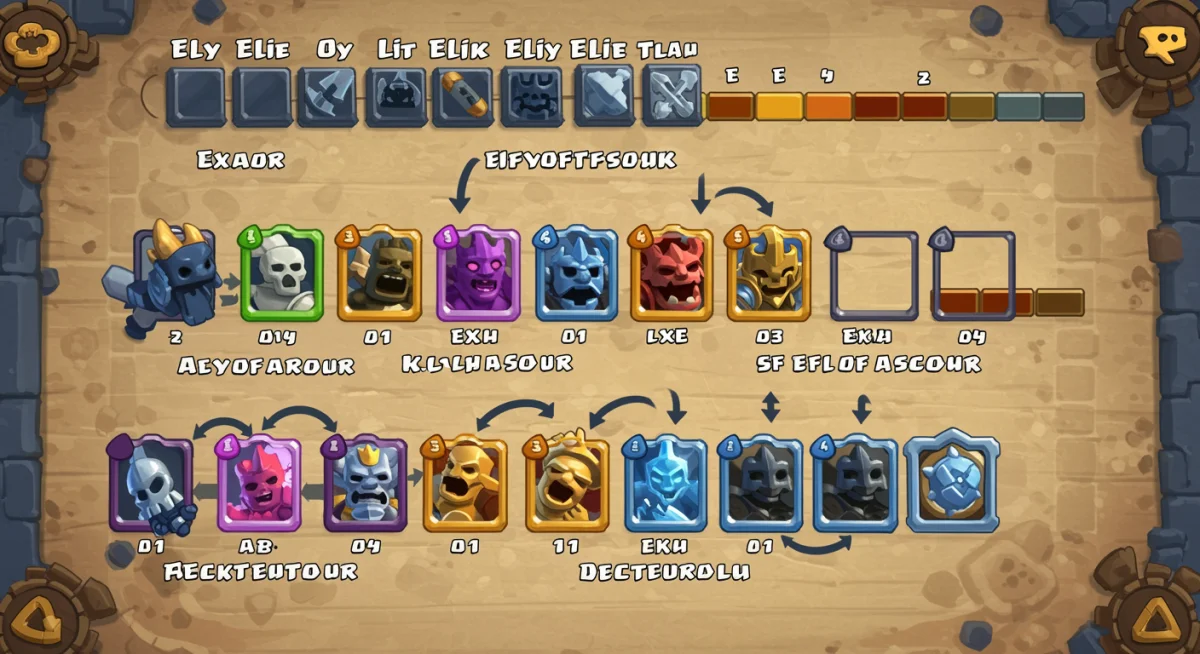
Adapting to Meta Changes and Personal Playstyle
The Clash Royale meta is constantly evolving, with balance changes, new cards, and emerging strategies. What works today might not be as effective tomorrow. Therefore, a crucial aspect of mastering defensive strategies is the ability to adapt, experiment, and refine your approach based on the current game environment and your personal playstyle.
Staying informed about the latest meta trends, watching top players, and analyzing your own replays are all vital components of continuous improvement. Don’t be afraid to try new cards or adjust your deck to counter prevalent strategies. Flexibility is a strength.
Continuous Learning and Experimentation
Even the most seasoned Clash Royale players continue to learn and adapt. The game rewards those who are willing to experiment and not rigidly stick to outdated strategies. Your personal playstyle should also influence your defensive choices.
- Watch Pro Players: Observe how top players defend against various pushes. Pay attention to their card placements, timing, and elixir management.
- Analyze Your Replays: Review your losses and even your wins. Identify where you overspent elixir, made poor placements, or could have defended more efficiently.
- Experiment with Decks: Don’t be afraid to try new defensive cards or entire deck archetypes. Sometimes a fresh perspective can unlock new strategies.
- Understand Balance Changes: Keep up with Supercell’s balance updates. They often shift the meta and can make certain defensive cards more or less viable.
Ultimately, becoming a master defender in Clash Royale is a journey, not a destination. It requires dedication, continuous learning, and a willingness to adapt. By embracing these principles, you’ll not only protect your towers more effectively but also significantly increase your win rate and overall enjoyment of the game.
| Key Defensive Principle | Brief Description |
|---|---|
| Elixir Management | Efficiently spending elixir to counter threats and gain an advantage for future pushes. |
| Card Placement | Precise positioning of troops and buildings to maximize their defensive impact and lure enemies. |
| Deck Synergy | Building a balanced deck with cards that complement each other for diverse defensive scenarios. |
| Counter-Pushing | Transitioning successful defenses into potent offensive attacks to pressure opponents. |
Frequently Asked Questions About Clash Royale Defense
The most common mistake is overcommitting elixir, leading to a negative elixir trade and leaving yourself vulnerable. Players often panic and drop too many high-cost cards to defend a push that could have been handled with fewer resources, thus hindering their ability to counter-attack.
To defend against a Hog Rider, use defensive buildings like Cannon or Tesla placed centrally to pull it. Alternatively, units like Mini P.E.K.K.A. or Prince can quickly eliminate it. Spells like Tornado can also activate your King Tower, providing long-term defensive support.
Positive elixir trades occur when you use less elixir to counter an opponent’s card that costs more. For example, using a 3-elixir Knight to stop a 5-elixir Wizard. This creates an elixir advantage, allowing you to build stronger counter-pushes and maintain control of the game.
Not always. Sometimes, allowing minimal damage to a Princess Tower to save elixir for a powerful counter-push in the opposite lane can be a more strategic move. It’s about weighing the long-term game state against immediate tower health, often leading to a better overall outcome.
Practice is key. Watch replays to analyze your mistakes and learn from top players. Pay close attention to unit targeting and movement mechanics. Experiment with different placements in friendly battles. Consistent effort will naturally sharpen your defensive timing and card positioning skills over time.
Conclusion
Mastering Clash Royale Defensive Strategies is not merely about preventing tower destruction; it’s about building a foundation for consistent victories. By diligently practicing elixir management, understanding optimal card placements, developing synergistic decks, and adapting to the ever-changing meta, players can transform their defensive capabilities into potent offensive opportunities. The continuous pursuit of knowledge and refinement in these areas will undoubtedly lead to a more rewarding and successful Clash Royale experience, ensuring your towers stand strong against any challenge.

